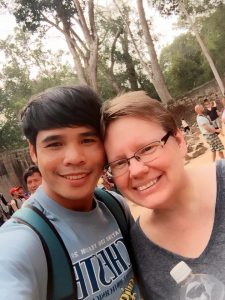1.1: Key Intercultural Communication Terms
- Last updated
- Save as PDF
- Page ID
- 79230
Defining Key Terms
“We may have all come on different ships, but we’re in the same boat now.”
–attributed to Dr. Martin Luther King, Jr. in a speech by Rep. John Lewis commemorating the
50th anniversary of the march on Washington D.C. (Washington Post, August 28, 2013).
Chapter Summary:

This chapter reviews many of the primary concepts related to intercultural communication in general and, in particular, defines and explores those concepts/skills most closely correlated to interviewing and student intercultural communication competence.
Understanding the standard definitions of terms and concepts within the discipline of Communication will help you write your essay. Note within your primary textbook and see the resource section for links to additional online materials. Terms to consider exploring in your preparation and/or essay include: communication; culture and selected components of culture (e.g. deep structure, cultural patterns and typologies); cultural identity; intercultural communication; perception, cultural values and beliefs; listening (compassionate listening necessary to provide the awareness and practical wherewithal for conducting an intercultural communication interview); uncertainty reduction; and finally, intercultural communication competence and the sojourner experience, consisting of motivation, possessing knowledge to draw upon, effectively exercising communication skills drawn from the terms and concepts above, and understanding the importance of the context in which one exercises these skills.

While the “Humans Unit” will include both skill-based and theoretical aspects and applications, it is hoped that students will, as a result of the process described above, gradually become a culturally curious, confident and competent communicator in a wide variety of intercultural communication encounters. Now, once gained, intercultural competencies may be deepened and tested through travel, perhaps contributing in a profound sense to an authentic sojourner experience, discussed below. It is a brute fact that one semester in the classroom, while perhaps necessary, is simply not sufficient to learn with full substance or depth the vast set of various life skills necessary to effectively function in a different culture or navigate our globe’s diverse cultures; that is, the classroom cannot be the sole path to progress in one’s ability to successfully navigate our common village of cultural variety brought about, for good or ill, by the forces of globalization. Likewise, a strictly scripted set of activities by a ship’s cruise director may bring you closer to another mammalian culture, such as swimming with the dolphins, but could ignore the authentic human culture found but a mile or two away from the Disney floating behemoths in ports of call such as the Bahamas, Jamaica, etc.
Communication Defined:

Communication loosely means “sharing and understanding meaning” or to “make common” (Pearson & Nelson, 2000). Community and communication share the same root word and, in “making common,” we find a means to use verbal (words) and nonverbal (non-words) symbols to reduce uncertainty.
Defining communication is difficult; however, the goal of human communication is simply to share and understand the same meaning. Professor Schultze puts it straightforwardly: “If you don’t understand what I am actually intending to say, we failed to communicate. Such lack of shared understanding is miscommunication, not communication” (Schultze, n.d.). Samovar, Porter, McDaniel, & Roy (2017) posit that “…human communication is a dynamic process in which people attempt to share their thoughts with other people through the use of symbols in particular settings” (p.28).

In intercultural settings, the communicators might not share the same language. Therefore, nonverbal communication takes on an additional emphasis. “Nonverbal communication is a process of generating meaning using behavior other than words. Rather than thinking of nonverbal communication as the opposite of or as separate from verbal communication, it’s more accurate to view them as operating side by side—as part of the same system” (Communication, 2016, p.165).
All communication happens within a context or communication situation. When the context includes individuals from different cultures, there is a unique potential for both uncertainty, but also room for growth as the communicators learn from one another. Examining the definition of culture assists in this growth.
Culture Defined:
Culture is communication and communication is culture ~ E. T. Hall (1959)

Defining culture can be imprecise; there are hundreds of academic definitions each of which highlight a different aspect or nuance to suit their own particular approach. Samovar, Porter, McDaniel, & Roy (2017) explain, “Culture is a set of human-made objective and subjective elements that in the past have increased the probability of survival and resulted in satisfaction for the participants in an ecological niche, and thus became shared among those who could communicate with each other because they had a common language and they lived in the same time and place” (p.39).
Another definition from Lustig & Koester (2005) in their book, Among Us, explains, “Culture is a learned set of shared interpretations about beliefs, values, norms, and social practices that affects the behaviors of a relatively large group of people. Thus culture is linked to human symbolic processes” (p.13).
Finally, a simpler definition comes from Communication in the Real World: An Introduction to Communication Studies (2016), “Culture is an ongoing negotiation of learned patterns of beliefs, attitudes, values, and behaviors” (p.377).

Samovar, Porter, McDaniel, & Roy (2017) stress family, worldview, religion, history, values, social organizations and language as vital elements of culture. These elements of culture might help one better understand how intercultural communicators both share and differ in a variety of ways. “Worldview is the way a people interpret reality and events, including their images of themselves and how they relate to the world around them” (p.57). When one explores another’s culture, oftentimes one finds they are doing likewise.
This sense of definitional ambiguity has been discussed in the Open Education Resource (OER) Communication in the Real World: An Introduction to Communication Studies (2016) as quoted below:

Culture is a complicated word to define, as there are at least six common ways that culture is used in the United States. For the purposes of exploring the communicative aspects of culture, we will define culture as the ongoing negotiation of learned and patterned beliefs, attitudes, values, and behaviors. When unpacking this definition, note that culture shouldn’t be conceptualized as stable and unchanging. Culture is “negotiated,” and…is dynamic….The definition also points out that culture is learned, which accounts for the importance of socializing institutions like family, school, peers, and the media. Culture is patterned in that there are recognizable widespread similarities among people within a cultural group. There is also deviation from and resistance to those patterns by individuals and subgroups within a culture, which is why cultural patterns change over time. Last, the definition acknowledges that culture influences our beliefs about what is true and false, our attitudes including our likes and dislikes, our values regarding what is right and wrong, and our behaviors. It is from these cultural influences that our Defining identities are formed (p.377).

Regardless of the definition used, individuals who have traveled to a new culture (or born witness to a newcomer to their area), especially outside their own language, know the simple frustrations of learning how to park the car correctly, use the correct currency, let alone ask for directions arise from cultural differences. To reduce frustrations, developing a variety of intercultural communication skills is helpful.
Defining Intercultural Communication:

Having reviewed the definitions of culture and communication, looking more carefully at the defining characteristics of intercultural communication is essential to this Unit. Implicitly, if not explicitly, underpinning any definition of intercultural communication is one simple proposition–the requirement of a personal interaction with someone of a different culture, be that an intercultural interview or something else. If sharing and understanding meaning is our goal, our goal in intercultural communication is to do so in diverse settings with individuals who are from cultures different than our own. Hence, Lustig and Koester (2011) in their textbook, Intercultural Competence, briefly define intercultural communication as follows: “Intercultural communication occurs when large and important cultural differences create dissimilar interpretations and expectations about how to communicate competently” (p.52).
Intercultural communication happens in all contexts of communication: intrapersonal, interpersonal, small group/team, public, mass, mediated, etc. For a fuller treatment on Intercultural Communication, you can visit Communication in the Real World: An Introduction to Communication Studies (2016) discussion on the topic: http://open.lib.umn.edu/communication/chapter/8-3-intercultural-communication/. This author shares:
It is through intercultural communication that we come to create, understand, and transform culture and identity. Intercultural communication is communication between people with differing cultural identities. One reason we should study intercultural communication is to foster greater self-awareness (Martin & Nakayama, 2010). Our thought process regarding culture is often ‘other focused,’ meaning that the culture of the other person or group is what stands out in our perception. However, the old adage ‘know thyself’ is appropriate, as we become more aware of our own culture by better understanding other cultures and perspectives. Intercultural communication can allow us to step outside of our comfortable, usual frame of reference and see our culture through a different lens. Additionally, as we become more self-aware, we may also become more ethical communicators as we challenge our ethnocentrism, or our tendency to view our own culture as superior to other cultures (Communication, 2016, p.404).

When defining intercultural communication, it is important to remember these five thoughts as you complete your intercultural interview: “Engaging in intercultural communication is a complex activity. You need to be aware of (1) the uniqueness of each individual, (2) the hazards of over-generalizing, (3) the need to be objective, (4) the necessity for compromise, and (5) the myth of believing that communication is a cure-all” (Samovar, Porter, McDaniel, & Roy, 2017, p.17). In doing so, the ultimate goal is to develop one’s intercultural communication competency and integrate this into their own life.
What is intercultural communication competence?

According to Darla Deardorff (2004), “Intercultural [communication] competence is the ability to interact effectively and appropriately in intercultural situations, based on specific attitudes, intercultural knowledge, skills and reflection” (p.5). A pyramid model represents how desired outcomes, both internal and external, are achieved by acquiring necessary preliminary competencies and skills. Deardorff’s model of intercultural communication competence, influential in its field, is explained (along with other similar models) at: https://centerforinterculturaldialogue.files.wordpress.com/2010/07/intercultural-communication-competencies-study-material.pdf ).
A visual depiction of the model is shared at www.nafsa.org/_/file/_/theory_connections_intercultural_competence.pdf .
Undergirding Deardorff’s pyramid of intercultural communication competence and comprising its foundation are three characteristics allowing for its development and excellence: (1) motivation — developing cultural curiosity, general openness and respect for self/others; (2) knowledge — having a fund of knowledge to draw on to develop deep understanding, gaining knowledge of culture as well as specific cultural information and sociolinguistic awareness; (3) skills — possessing certain communication and listening skills such as listening, interpreting, analyzing, and evaluating (Samovar, Porter, McDaniel, & Roy, 2017, p.217).
Specifically, as an exercise of intercultural communication competence, this unit adapts Deardorff (2004), Samovar, Porter, McDaniel, & Roy (2017) and others to: first, assist the student to thoughtfully prepare for the intercultural interview; second, gives the student a sense of how to effectively conduct the interview using perception checks, employing nonverbal and verbal skills, enhancing active listening and integrating compassionate listening when appropriate; and, third, help the student to prepare for the course’s essay assignment.
About the Unit’s Assignment:

The course unit assists the student in writing a brief essay assignment to demonstrate progress towards intercultural communication competence. To this end, the essay focuses upon personal reaction to, and acquired knowledge and analysis of, certain aspects of another culture relevant to effective intercultural communication leading to some measure of intercultural competence. The assignment asks the student the following: 1) learn about, and be aware of, one’s own culture and how it has shaped who and what one is so that honest and sound research of another culture to which she does not belong may occur; 2) interview someone from, or closely associated with, that culture and; 3) write a personal narrative analyzing the aforementioned process and the intercultural communication/interviewing experience arising from prior research, the process of the intercultural interview, and the connection made through the intercultural interview with a person of a different culture. A full assignment sheet, sample outlines and sample student essays are provided in the second section of this online resource.
Preparing for the Intercultural Interview:

First and foremost, an intercultural interview should be conducted in a safe environment enabling both interviewer and interviewee to ask genuine, honest, and respectful questions with like tenored responses given. The interview, though, must be more than a loose exercise in stream-of-consciousness questioning. Hence, preparation for the interview is absolutely necessary as questions and prompts will need to have some connection or relevance to the student’s essay. For example, the student will want to read corresponding chapters and sections from the primary textbook and other relevant resources, paying attention to cultural patterns and taxonomies/typologies as listed below one or more fitting to your essay and one or more with which you are comfortable along with concepts including, but not limited to, cultural identity, intercultural verbal and nonverbal communication, perception, and listening. Consider:
- Kohl’s Analysis of American Cultural Patterns
- interculturalcomm.wikispaces.com/Kohls%27+Guide+to+American+Values
- Hall’s High-Low Context Cultural Taxonomy
- online.seu.edu/high-and-low-context-cultures/
- www.helsinki.fi/~tella/nishimuranevgitella299.pdf
- http://www2.pacific.edu/sis/culture/pub/context_cultures_high_and_lo.htm
- Hofstede’s Cultural Taxonomy
- www.hofstede-insights.com/product/compare-countries/
- Kluckholm and Strodtbeck’s Value Orientations
- Project Globe which builds upon Hofstede and Kluckholm and Strodtbeck’s work, Minkov’s Cultural Dimension, etc.)
- GlobeProject http://globeproject.com/
- www.ccsenet.org/journal/index.php/ijbm/article/%20viewFile/10431/7448
- https://www.tlu.ee/~sirvir/IKM/Leadership%20Dimensions/about_this_learning_object.html

Sample questions for an interview, then, may include, in some fashion, the manner in which the interviewee experienced a collective vs. an individualistic family structure. Consider the variety of questions one could ask: Did you feel like a team or more as individuals in your family? Did your country stress what was “good for the country” or “what is good for the individual citizen?” Can you explain? How were decisions made in your family (e.g. where you’d go to college, who is responsible for what chores, etc.)?
Thinking about the questions to ask during the interview and considering the course content one would like to explore is helpful. At the same time, one will want to “just listen” without asking questions for some of the interview time. Chapter 6 focuses on how to use “active listening” as well as “compassionate listening skills” depending upon the context.


